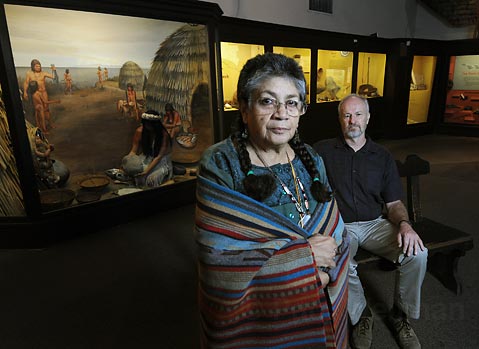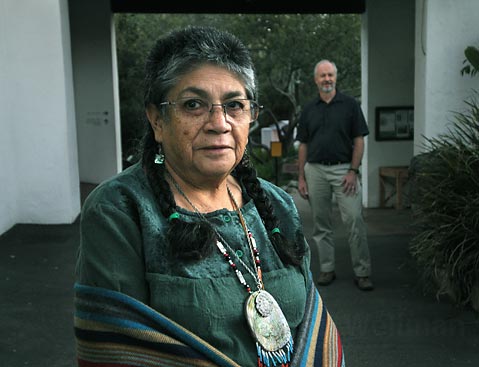Two Centuries of Chumash
Ernestine Ygnacio-De Soto's Six Generations Saga to Air on KCET and at Museum of Natural History

It’s impossible to grow up in the United States without repeatedly encountering stories about the Native American experience. But, unfortunately, almost all of those tales tend to be about men and frequently are focused on Southwestern or Northeastern tribes, leaving us clueless about the female perspective and keeping things deafeningly silent on the sagas of countless other First Peoples.
That’s about to change thanks to Santa Barbara’s Ernestine Ygnacio-De Soto, who-with the help of anthropologist John Johnson and filmmaker Paul Goldsmith-is bringing 200 years of matrilineal Chumash family history to the Southern Californian masses. Based on a storytelling performance that Ygnacio-De Soto has given to thousands of people throughout California during the past decade, the hour-long documentary Six Generations is set to air on KCET twice this week and, for those who’d prefer a bigger screen, will also be shown at the Santa Barbara Museum of Natural History on November 18.
Six Generations showcases Ygnacio-De Soto recounting six separate biographies, starting with her great-great-great grandmother and carrying on down the line to her mother, Mary Yee, the last speaker of the Chumash language, and to herself. As Ygnacio-De Soto channels her ancestors by telling each story in the first-person, the film showcases images from the respective eras, in much the same manner as Ygnacio-De Soto’s lectures, which were illustrated with simultaneous slideshows.
When cinematographer Paul Goldsmith saw one of these about nine years ago, he knew the speech had serious cinematic hope. “I was just stunned,” said Goldsmith. “She took me through 200 years of history, starting on the beach in Santa Barbara the year the Spanish arrived and, when the lights came on, it was today. I’d never experienced history like that. It felt like I traveled through it on a rocket ship.”
The unique format developed out of the relationship between Ygnacio-De Soto and John Johnson, who first met in 1980 in the Santa Barbara Mission’s library. Johnson, now the Museum of Natural History’s anthropology curator, was then a grad student at UCSB, working on a dissertation about Chumash marriage and family patterns. “He was doing his thing with his long hair, his long beard, and Birkenstocks, of course,” recalled Ygnacio-De Soto, who was researching her mother’s history for a Native American studies class she was taking. “I knew who her great-grandmother was,” said Johnson, and that was all it took to strike up a friendship that continues to endure. When together, Ygnacio-De Soto and Johnson make for a slightly awkward pair-he’s a tall, studious white man, she’s a short, spunky brown woman, but both are apt to finish each other’s sentences like an old married couple. After years of giving the lecture, they knew it could be turned into a film, and went through two filmmakers before giving Goldsmith the green light about three years ago. “Paul really made it happen,” said Johnson, as Ygnacio-De Soto chimed in, “It’s his baby.”
Goldsmith initially thought he could just get out of the way and let Ygnacio-De Soto’s story shine. “I didn’t want it to be just another white man making a story about Native Americans,” he said. But it turned out to be a much more challenging process, and it wasn’t until he worked on the recent PBS series about Native Americans called We Shall Remain that he developed the right storytelling approach to make the theatrical performance work on celluloid.
Along the way, Ygnacio-De Soto’s story has taught him plenty. “I learned that there are certain situations where, if you have cultural abuse for generation after generation, you cannot just say, ‘I’m going to pull myself up from the bootstraps,'” said Goldsmith, reflecting on how Ygnacio-De Soto’s family watched their culture get decimated throughout the decades. “The weight of history does exist today.” That’s not to say that the story is a total downer. “I never wanted it to end as a sort of tragedy,” he explained. “Ernestine is not asking for your sympathy, that’s pretty clear. It is about survival.”

The film, which will one day be available on DVD, is actually now itself a tool of cultural survival, in that it recounts Native American stories from the years between the end of the California Mission era in the 1830s and the modern era, a span of time when there wasn’t really any Indian history being recorded because many of those with native blood tried to hide it. “Native American history really went underground for 100 years,” said Goldsmith. “This story fills in some of that and gives you an idea of what was going on.” Johnson agreed, explaining, “I hope it gets people to see that the Indian story did not end with the missions.”
Goldsmith believes Six Generations is truly one-of-a-kind. “This may be the only story like this in America,” said Goldsmith, giving a lot of credit to legendary anthropologist John P. Harrington, who spent much of the early 20th century documenting the Chumash people and making personal connections with Ygnacio-De Soto’s ancestors. “Because Harrington came to work with her family, he sort of validated them, so the family continued to tell the stories. The fact that there is an unbroken line of stories going back to the first contact, I don’t know if there is another story in America like this.”
4•1•1
Six Generations will be on KCET this Thursday, November 12, at 8:30 p.m. and Sunday, November 15, at 4 p.m. It will also be shown at the S.B. Museum of Natural History on Wednesday, November 18, at 7:30 p.m. See sbnature.org.



